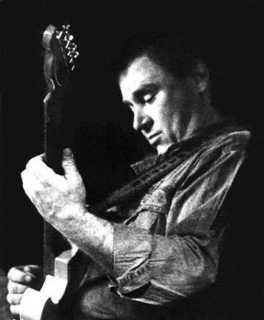
In a previous post "The New Rockabilly Geography" I pointed out just how far reaching the genre's influence is felt in the contemporary music scene. Literally hundreds of rockabillyesque groups have appeared all over the globe, and its popularity seems to be increasing rather than diminishing. Where did this all begin? In order to symplify, I will agree with Billy Poore's claim that rockabilly was "born" in the Sun studios in July of 1954, with Sam Phillips orchestration of Elvis and Scotty Moore doing The Arthur Crudup classic " That's All Right Mama." Once that tune became a hit, the style simply caught fire for the next five or six years, then faded, until....
Rockabilly was not popular during the 1960's and even into the 1970's, save a few peculiar exceptions. The Beatles' great covers of Carl Perkins, Bobby Fuller's 1966 hit "I Fought the Law" and CCR's covers of the Dale Hawkin's hit "Suzie Q" and Roy Orbison's "Ooby Dooby." By the early 1970's, while most U.S. bands were either pursuing "country rock" or a more bluesy mode, Commander Cody was forging a most eclectic style by exploring the diversity of American roots back to the 1940's. Cody's cover hit of the old Charlie Ryan tune "Hot Rod Lincoln," which was probably more inspired by the Johnny Bond version, became a hit in 1972 and stood out as one of the few links to the rockbilly style in the eary 70's.
What is generally referred to as the "second wave" of rockabilly appears in the later 1970's, and some have argued that it was an offshoot of the British punk rock scene. While that claim is dabatable, what is documentable is that Robert Gordon really got the rockabilly train rolling again in 1977 as he teamed up with Link Wray on the Billy Lee Riley classic "Red Hot" which hit the charts in the fall of the same year. Gordon went on to record five subsequent albums, teaming with other "red hot" guitarists like British session ace Chris Spedding and the incomparable Danny Gatton on different LP's.
On the other side of the Atlantic, Dave Edmonds was ahead of the game as he began mining the American music tradition to create hits like his cover of the Smiley Lewis ryhthm and blues classic "I Hear You Knockin," which was a top ten song in 1971. His later album and Rock Pile, released in 1972, was also true to the roots, containing many covers of American 1950's classics. Several years later here in the states Brian Setzer's Stray Cats also hit it rather big in the early 1980's, and their popularity helped boost awareness of rockabilly in general. During the same period, Jinx Jones and his Jaguars were exploring rockabilly styles with success in the Denver area, check out Jinx's blistering guitar chops here. Also contributing to the fun was Dave Alvin's outfit, The Blasters, whose first LPs, American Music (1979), was an amalgamation of rockabilly and R&B roots music and was a success in launching Alvin's career. Curiously, Danny Gatton's 1975 LP with his group Danny and the Fat Boys, which was also entitled American Music, featured a diverse offering of 50's material which highlighted the Warren Smith's rockabilly classic Ubangi Stomp as well as a tribute to the 1950's R&B star Amos Milburn.
Finally, I would be remiss with discussing an exceptional group from my home state of Missouri whose unique blend of retro esoterica and rockabilly got me very interested in the genre back during the second wave. Seeing band leaders Lou Whitney (bass) and D. Clinton Thompson (guitar) perform live in 1979 with their first group The Symptoms and rip through the Johnny Burnette classic "Rock Therapy" or cover Chuck Berry's "Too much Monkey Business" was a transformative experience. The group later morphed into The Morells but the outcome was the same: an outstanding and very original retro sound. Whether it was covering obscure rockabilly numbers like Ronnie Self's "Ain't I a Dog" or doing sizzling originals like "Reds" or "Trans Am," The Morells have made a name for themselves in a way some of the other groups mentioned here could not, and they are still doing it.



















